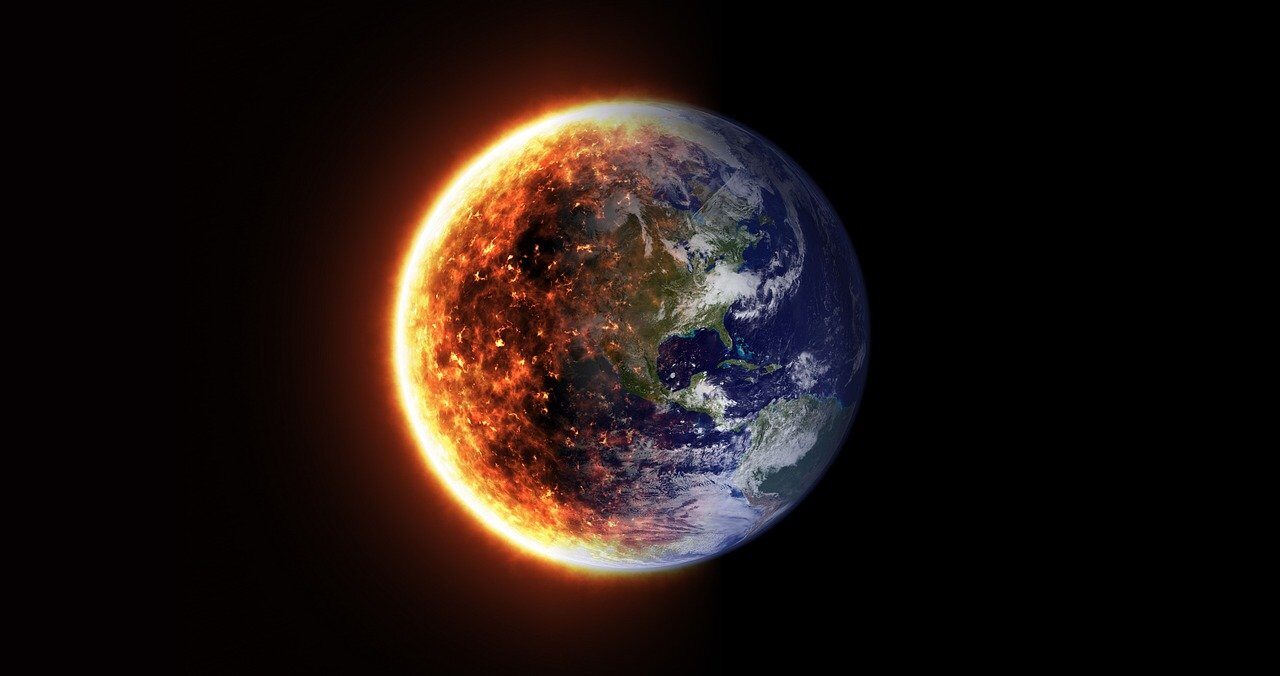Prof. Piotr Wolański: The variable activity of the Sun has the greatest impact on climate change

Even complete cessation of CO emissions2 to the atmosphere generated by human activities will not affect the Earth’s climate. Despite the fact that the variable activity of the sun had, has and will have the greatest impact on climate change, we should still protect our environment – writes in the article “Climate and Man” prof. dr hab. Eng. Piotr Wolański, chairman of the Space and Satellite Research Committee of the Polish Academy of Sciences.
Climate, from Gr. propensity is the totality of weather phenomena in a given area over a long period of time. It is determined on the basis of many years of observations of various components, such as measurements of temperature, precipitation and wind. The Earth’s climate is shaped by three basic climate-forming processes: the heat cycle, the water cycle and the air circulation.
The primary source of heat on earth is the energy provided by the sun. It is heat transferred by the sun in the form of radiation absorbed by land, water surfaces and the atmosphere. Some of the solar energy reaching the Earth is reflected by land, water and clouds and re-radiated to space. Part of the absorbed energy causes heating of the surface of land and oceans and causes the evaporation of water from the surface of oceans, land water reservoirs, rivers or wet surfaces.
Solar energy absorbed in the atmosphere raises its temperature and forces water and air circulation, in other words, it is the source of winds and precipitation, rain, snow, etc. Heated lands and oceans emit thermal radiation in the infrared range, part of which leaves our planet into the space that surrounds us part is absorbed by greenhouse gases and partly emitted into space and partly back to the earth’s surface. This phenomenon is called the greenhouse effect and thanks to it the average temperature on our planet is about 15 degrees Celsius. Without the greenhouse effect, the temperature on earth would be about 18 degrees Celsius lower.
The main greenhouse gases in our atmosphere are: water vapor which, according to various estimates, is responsible for 70-99% of the entire greenhouse effect, the others are carbon dioxide, methane, nitrogen oxides and others. Particulate matter also has a significant impact on the heat balance in the Earth’s atmosphere. They come from various sources, such as: volcanic eruptions, desert storms, forest fires or, in industrial times, emissions from industrial plants, coal power plants, cars, agriculture, individual heating furnaces, etc.
According to today’s assessments, the most important influences on the climate are: the sun, volcanic activity, greenhouse gases, sea currents (heat circulation in the ocean, e.g. El Ninio, Gulf Stream) and, to a lesser extent, other factors such as e.g. the precession of the Earth’s axis. The degree of impact of these factors on climate change has undergone major changes in the past, in particular during the period of strong volcanic activity, which resulted in the emission of huge amounts of dust into the Earth’s atmosphere, blocking solar radiation, which in turn led to a cooling of the climate.
Climate variability on Earth
The climate on Earth has been constantly changing since the very beginning of our planet’s formation. Information about climate variability from the early period of our planet’s existence, however, is burdened with a large measure of uncertainty. Relatively good information about climate variability comes from data obtained from ice core drilling in Antarctica. From gases and dusts frozen in bubbles, it is possible to estimate the composition of the atmosphere at that time, the content of dust, and indirectly determine the temperatures that prevailed on Earth at that time. They show that in the last 450,000 years, we had four long ice ages lasting from about 80,000 years to over 100,000 years. years, which were interspersed with short, interglacial periods of warming, lasting about 15,000 years. years or less.
As you can see in the attached graph showing changes in temperature on Earth over the last 450,000 years, determined on the basis of the analysis of the content of ice in the wells in Antarctica, there is a clear correlation between temperature and the content of CO2 and dust in the atmosphere. There is a clear correlation between cold periods and the content of dust – the more dust, the lower the temperature. An increase in temperature is accompanied by an increase in the amount of carbon dioxide in the atmosphere. Detailed analysis, however, shows that the increase in carbon dioxide content was always a secondary effect caused by the increase in temperature, leading to an increase in the temperature of the water in the oceans and thus releasing more CO2 from the ocean, similar to how carbonated water is heated, which releases carbon dioxide as the temperature rises. dissolved carbon dioxide into the atmosphere.
At the end of the last Ice Age, a rapid increase in temperature begins, which causes a rapid melting of the glacier covering the northern hemisphere in America from the northern part of the United States, Canada, Greenland and the Arctic, and in Europe from the northern part of Poland, Germany, Great Britain, Scandinavia and northern Russia and part of northern Siberia. It is estimated that the thickness of this glacier was about a kilometer in the southern region of the glacier and up to four kilometers in the polar regions. Water from the melting glacier caused the sea level to rise by more than 120m. However, in the Black Sea, which was previously an inland lake, the flowing water from the melting Siberian glacier caused an increase of as much as 200m. In the Black Sea at such a depth there are sunken remains of fishing settlements. It should also be added that the rate of sea level rise during the period of the most intense melting of the glaciers was 29 m/1000 years, i.e. 2.9 m/100 years. Today, the growth rate of this level is only 0.18 m per hundred years. The intense melting of the glaciers lasted until about 6,000 years ago. BC, which does not mean, however, that there were no climatic changes during this period. Information about these changes from the records of ancient chroniclers, however, is not precise. On the other hand, analyzes of the content of radioactive carbon 14C in fossils give more objective information about solar activity, which determines the amount of radioactive carbon reaching the Earth 14c
Although the first attempts to build a thermometer were made about 2,000 years ago. years ago, precise temperature measurements began at the turn of the 17th and 18th centuries. Despite the lack of precise temperature measurements, we know that about 1000 years ago, during the so-called During the “troubadours” there was a warm period throughout Europe, which was characterized by the fact that even in Great Britain plants and animals lived, which now are found only in the Mediterranean. At that time, moreover, the Danes discovered Greenland, the “Green Continent”, and cows were raised in Greenland and even a bishop’s abbey was founded. After this warm period, two so-called The Little Ice Ages, the Spörer minimum in the years 1460 – 1550, the Mauder minimum in the years 1645 to 1715 and the cooling in the early 19th century called the Dalton minimum. The last two minima/cooling are closely correlated with the sunspotless period, which suggests that during the period of reduced solar activity, i.e. no sunspots, the Earth’s climate is cooling. During the period of no sunspots, the thermal energy from the Sun drops by only 0.1%, which is not a significant difference in the amount of energy that reaches the Earth. It is true that during this period the amount of ultraviolet energy reaching us decreases significantly, but this cannot have a large impact on the Earth’s energy balance. However, during the minimum of solar activity there is a change in the polarization of the Sun’s magnetic field, which additionally practically disappears during this change. The sun, or more precisely its field, which is practically absent, no longer protects the inner part of the solar system from the action of high-energy cosmic ray particles.
This radiation, according to James A. Maruseka, initiates the condensation of ice crystals in the atmosphere and the formation of more clouds. This process causes the Earth’s albedo to increase, i.e. more solar radiation is reflected from the cloud surface and less solar energy reaches the Earth. In addition, currents are generated that increase air circulation from the polar regions to areas located in the temperate zone. These two processes lead to a significant cooling of the climate in this area. James A. Marusek compared the solar activity of the late 18th and early 19th centuries (solar cycles SC3-SC5 from 1775-1811 with the current cycles SC22-SC24 from 1987-2020?). The correlation of the last 3 cycles with the CS3-CS5 cycles is 85.94%, which, according to James A. Marusek, predicts a cooling for more than 20 years or more? At the end of the SC5 cycle, winters in Europe were extremely harsh (Dalton Minimum), which was experienced by Napoleon’s army returning from an expedition to Moscow. It should also be added that between the cycles SC23-SC24 in the years 2009-2013 we had as many as four winters in a row in Poland with the average national temperature below the long-term norm. This cycle was interrupted only by the winter of 2013/14, which turned out to be mild. Since the cooling occurs with some lag from the activity minimum (system inertia), cooling in the northern hemisphere should be expected right now.
The greenhouse effect
As I mentioned earlier, the main greenhouse gas in the atmosphere is water vapor, while according to real estimates, carbon dioxide is responsible, according to various estimates, for 1-30% of the greenhouse effect. It should also be added that 95% of the carbon dioxide contained in the atmosphere comes from natural emissions (mainly from the discharge from the oceans and from volcanic eruptions), while the human contribution to this emission is only 5%. The contribution of anthropogenic CO2 emissions to the greenhouse effect is at most about 1%, assuming that water vapor has only 70% share in the greenhouse effect, while with a greater share of water vapor in the greenhouse effect, the share of carbon dioxide emitted by humans in this effect will be practically negligible.
It should also be noted that in the past, the United States, Germany, China and the Soviet Union emitted the most carbon dioxide into the atmosphere, while currently (data from 2015) China, the United States and the European Union emit the most. On the other hand, in the European Union, Germany emits the most in this aspect, which is responsible for 23% of CO2 emissions in the entire EU. The following countries are Great Britain 12.5%, Italy 10.6%, France 9.9%. Poland is in fifth place, emitting 9.2% in 2015. of all carbon dioxide released into the atmosphere from EU countries.
We also need to look at the impact of increasing CO2 in the atmosphere on the growth of plants on our planet. According to NASA satellite analyzes carried out in the years 1982-2015, there was a significant increase in green areas on the surface of the Earth. It also has a positive effect on the increase in the oxygen content in the atmosphere, produced in the process of photosynthesis.
In summary, it should be said that thanks to the Greenhouse Effect, we have a temperature on Earth that is about 18 degrees Celsius higher than without this effect. The contribution of anthropogenic CO2 emissions to the greenhouse effect is less than 1% and has no noticeable impact on the observed changes in the Earth’s climate. Natural factors, in which solar activity plays a major role, have a dominant influence on climate change. As can be seen from the analysis carried out in the last 450 thousand. The climate on our planet has been constantly changing for many years, the best proof of which were the successive ice ages and short interglacial periods.
Highly developed countries promote the thesis that human activity has a fundamental impact on climate change in order to force developing countries to buy their ecological technologies. One of such actions is the introduction of a limit on carbon dioxide emissions into the atmosphere. It should be noted that even the complete cessation of CO2 emissions into the atmosphere generated by human activity will not affect the changes in the Earth’s CLIMATE! Despite the fact that the changeable activity of the SUN had, has and will have the greatest impact on climate change, we should still protect our environment!
Author: Piotr Wojciech Wolanski
Piotr Wojciech Wolanski – Polish scientist, professor of technical sciences specializing in aviation and space propulsion, internal combustion engines, combustion, thermal technology, explosions. Full professor at the Institute of Aviation in the ŁUKASIEWICZ Research Network. Professor Emeritus of the Warsaw University of Technology Coordinator of work on the first Polish satellite of the Earth PW-SAT.






